“We did not reinvent the wheel, but actually the complexity of this 8-voice true analog multitimbral synthesizer hasn’t been there yet. The term ‘8-fold storable modular system’ would describe this unit in a much better fashion, and exactly this is the SunSyn.” (Jomox)
Right, Jürgen Michaelis constructed a modern, true analog polyphonic synthesizer. And then – just to make things perfect – he also built the instrument in his own shop. Instead of “made in China” (as with many competitors) the SunSyn is “built in Germany”.
Sure, the basic idea of the SunSyn is not really new. A modern, polyphonic analog synth that takes reference to the sound of the good old vintage classics – the great analogue “wouummmm” combined with all the advantages of modern technology, such as unlimited program memories, MIDI (plus all the beautiful cc controllability), and – last but not least – not too expensive!
Well, we know that “price” is relative. A Sequential Prophet-5 or a Roland Jupiter-8 cost some 6,000 – 7,000 Euros back in their days. Compared to those classics, the SunSyn – shipped for the first time in 1999 – was a real bargain: it cost a mere 2,300 Euros.
Still, 2,300 Euros was tremendously expensive for many musicians. Their whole studio was a lot cheaper, so why the hell should a synthesizer cost more than two grand? Price was thus a big problem. And the first SunSyn machines were shipped with quite a few bugs, and the instrument didn’t sport all the great features that musicians were expecting. No wonder the SunSyn is a rare animal, not often seen in studios.
The software would be cheaper, but these are real analog envelopes
Our digital world enables the cheap implementation of many important components. Software envelopes, software-LFOs, etc. are cost-effective modules used in many modern analog machines. Digital technology adds many important functions with little extra cost. And thanks to real VCF and VCA modules, most of the modern “analog” synths still sound much better than their virtual analog competitors. Jürgen Michaelis, however, developed a synthesizer with no compromises. The SunSyn sports real analog components, making it one of only few truly analog (modern) synthesizers.
Considering that the SunSyn is an 8-voice machine with a vast modulation matrix, it’s no wonder that it took Jürgen Michaelis many years to finish the instrument. The first prototype was on exhibition at the Frankfurter Musikmesse in 1998. One year later the SunSyn was officially shipped for the first time, but it took another five (!) years of software updates and hardware modifications to bring the instrument up to what it is now.
The SunSyn has heaps of interesting and complex features. As the instrument is described in detail in many (online) articles, this review will concentrate on its basic architecture and on some unusual extras.
8 voices, 2 VCOs and 2 RCOs per voice
This is an 8-voice multi-timbral synthesizer with 2 VCOs and 2 RCOs per voice. For those who don’t know what RCOs are: those are Ramp Controlled Oscillators – digital oscillators that can interact with the analogue ones.
“Every SunSyn voice has two true analogue oscillators, built up in discrete circuit technology and featuring the classic waveforms saw, square and pulse with pulsewide-modulation.
Besides that, every voice has two so called RCOs (Ramp Controlled Oscillator). It’s the first time digital waveforms can be mixed with true analogue VCOs. They can interact with the analogue VCO driven by software. Therefore digital waveforms become alive like never before and open up new dimensions of sound estethics. All in all you have 4 oscillators per voice, i.e. 32 at all…
Inside the machine you have 7 wavesets with 248 waveforms each stored in the internal flash to feed the RCOs. More wavesets are available via PCMCIA-card.” (Jomox)
Further, there are two LFOs per voice and a fully configurable 4 pole true analogue filter (switchable betwenn 12 dB, 18dB and 24 dB). Each pole can be used individually either as LowPass or HighPass.
“The filter section contains a fully configurable 4 pole true analogue filter. On each pole, high/lowpass characteristics and coefficients (i.e. the basic cutoff frequency for each pole) can be adjusted individually. So you have the possibility to crossfade continously from a typical Moog 4pole to an 18db – 303 lowpass to an Oberheim-like 2pole filter.
Additionally, using the HP/LP switching for each pole, it is possible to create the most spacy bandpass- and highpass-filter sounds.
Furthermore, you can store all filter-parameters in 2 scenes and MORPH (in the analogue domain!) between them.” (Jomox)
I personally prefer a simple LP/HP/BP switch to this rather confusing system of individually configurable filter poles. But sure, it’s a question of personal taste. And the possibility of morphing between two filter scenes is quite unique!
Analogue modulation matrix: 16 sources – 15 destinations
The routing system of the SunSyn is another exciting feature. There are four flexible and programmable routing paths, each offering 16 sources and 15 destinations.
“You can picture routing elements as a modular system’s cable, with two inputs (sources) and one output (destination). They are connected by an electronically controlled knob (modifier) to control the intensity.” (Jomox)
“The intensity itself can be modulated by any Midi-Controller (e.g. controller, velocity, aftertouch) or by an analogue audio-signal from the SunSyn. So you create ‘modulated modulations’.
Besides that, the signals of each voice can modulate among each other. Up to now, this was only possible with ‘real’ (and huge) modular systems.
Everything works of course in the analogue domain. Therefore no operation is limited by fixed point calculation errors (as in DSPs), but instead offers full dynamic-range for chaotic effects which apear on many modulations.
Every modulation path is easy edited and understandable by one single view on the front panel.” (Jomox)
The modulation matrix itself is not the point. What makes this routing system so wonderful is the analogue spirit of its modulation sources. This synth uses real (analogue) envelopes that turn it into something like a real analogue modular system (instead of a VA or semi-digital one). It’s capable of brilliant FM- and cross-modulation sounds.
Besides that there is a stereo input to send external audio signals or control voltages into the SunSyns routing system. You can use audio- or cv-signals as modulator signal. That’s brilliant, allowing for extreme fx-sounds, possible thanks to the truely analogue concept of the instrument.
The competition: Andromeda A6, Omega 8, Poly Evolver, Prophet-12 …
There are a few synths that seem to be similar to the SunSyn. First, the popular Alesis Andromeda. It has 16 voices, 2 VCOs + sub oscillator per voice, (digital) effects plus the keyboard. Second, the Studio Electronics Omega Expander with 8 voices, Moog and Oberheim filters (ARP 2600, CS-80, TB-303 filters are expandable). This one costs a mere 4,700 Euros, twice as much as the Alesis did …
Third, the DSI Poly Evolver Keyboard (or Poly Evolver). Well, this one is different in many little ways. It has only 4 voices, and although this ought to be a polyphonic synthesizer, I personally look at it as an instrument that consists of four Mono Evolvers (in the chassis of a poly-synth). You may use it polyphonically, if you wish to…
Of course we may not forget the new DSI Prophet-12. It looks nice, has some interesting features … just how much of a classic sound does it have? And then there’s the John Bowen Solaris. Ok, the Solaris is digital, but it sounds huge. And its voice architecture is sensational … we recommend comparing the SunSyn audio material (below) with our Solaris demos.
Concerning usability, the Alesis might be the worst choice. The Omega-8 and the Poly-Evolver both allow for better (direct) access, and for better handling. The sound of all competitors is, of course, very different to the SunSyn in every conceivable way. Keep in mind – the SunSyn has true (!) analog envelopes.
You’re right – software envelopes are not that bad any more. They are now much faster, and sound quite good. But analogue envelopes are still something different. I’d say it’s like eating freash tomato soup (with those wonderful tomatoes from your garden) in comparison to an industrially-made soup from the shop…
The SunSyn has a marvellous earthy analogue sound character. It’s similar to the Roland Jupiter-4 (if you know that one…), but with two (or, to be exact, four) oscillators per voice…
Analog rawness
I like it, the instrument’s raw analog sound. A simple saw-wave (with very little filtering) and some glide – that’s all you need for a great Moog-solo. Turn the filter to full, and feel its brutal power …
The RCOs turn the SunSyn into a very flexible synthesizer. If you’re tired of simple VCO-(de)tuning add some metallic, digital flair to your sound.
Very phattttttttt
I‘d say the SunSyn is a perfect instrument for all those who are looking for a genuine, raw-sounding analogue (polyphonic) synthesizer. Its punchy envelopes and great oscillators produce very phatt, purely analog, sounds.
The SunSyn is good, no, it’s is excellent. And it’s rare. Its current value is approximately 5,000 – 8,000 Euros.
SunSyn MK 2
The SunSyn has been discontinued in 2007. It was followed by the SunSyn MK2 in 2009/10. Both instruments were’nt sold in huge quantities, so it might take some time to find a SunSyn on the used-market. If you like the machine’s concept and – of course – its sound, then try to catch one…
Appendix: calibrating the SunSyn
- ENVELOPE CALIBRATION
Warm up the SunSyn for at least half an hour. Make sure that all VCOs are tuned before you start the envelope tuning!
Press Menu -> Global -> Tune. Select “Env” so that it reads “Att1 Decay1 Sust1 Voice”. Entering this submenu loads a special preset into the edit buffer (the underlying single patch will not be affected). Don’t tweak the ADSR1 knobs because this would change the basic parameters – best is to leave them at zero position before you enter the submenu. Exiting and re-entering this submenu will reload the test patch.
Press the button underneath “Voice”. This selects the voice to be calibrated. You have to press it once before the actual tuning procedure is entered. It doesn’t matter which key you press on the keyboard. When you press a key, an up- and down sweeping tone can be heard. At the peak points the time is measured in 10ms steps and displayed in the attack- and decay value. The correct value is 100 = 1000ms =1sec rise and fall time. If the value is too low, turn the respective encoder knob right to increase the value, left to decrease the value. You have to turn quite a lot since the resolution is fine. After the change of the value, trigger the envelope again to see the result. Repeat it until you get the desired value (100). Do it with the attack and the decay value to obtain almost 100 for each value. Due to the analog tolerances the value may differ from about 95 to 100.
Do this with every voice. If you are finished with the attacks and decays, turn the decay value low at the actual ADSR1 knob up right on the panel.
With the short envelope, select the voice with the highest basic tone (frequency) at sustain level 0. This will be you reference for the others. Remember the tone. Turn the respective encoder knob (3) right to increase the zero sustain level for the other selected voices. Match all voices for the same basic tone. If you have done this, you are finished. Press exit twice to leave the calibration menu.
- FILTER CALIBRATION
Warm up the SunSyn for at least half an hour. Make sure that all VCOs are tuned before you start the filter tuning!
Press Menu -> Global -> Tune. Select “Filtr” so that it reads “Cutof EnvAmt KeyTrck “. Entering this submenu loads a special preset into the edit buffer (the underlying single patch will not be affected). There is a resonant filter tone with a low VCO1 signal. The Filter offset can be adjusted with the knob below “Cutof”. Turning left decreases, turning right increases the value.
The whistling tone of the filter has to be 1 octave above the VCO at C4 (Note No.72) on the keyboard. It sounds almost like even tone, but it is an octave. Press and hold C4 and turn the offset encoder until the beating of the signals fades (mostly with uncalibrated filters downwards). If you are not sure, turn VCO1 level down and slightly up again, and you will find that the frequency of the whistling filter is forced a bit when the oscillator gets too loud.
The exact frequency beating is sometimes a bit hard to hear, but you get practice very soon. Do it with all voices. The voices are cycling with every pressed key.
Press exit twice to leave the calibration menu.
Now, here you can find the SunSyn sound examples. 30 minutes of music – enjoy!
Jomox SunSyn
Polyphonic analog rackmount synthesizer
8 voices

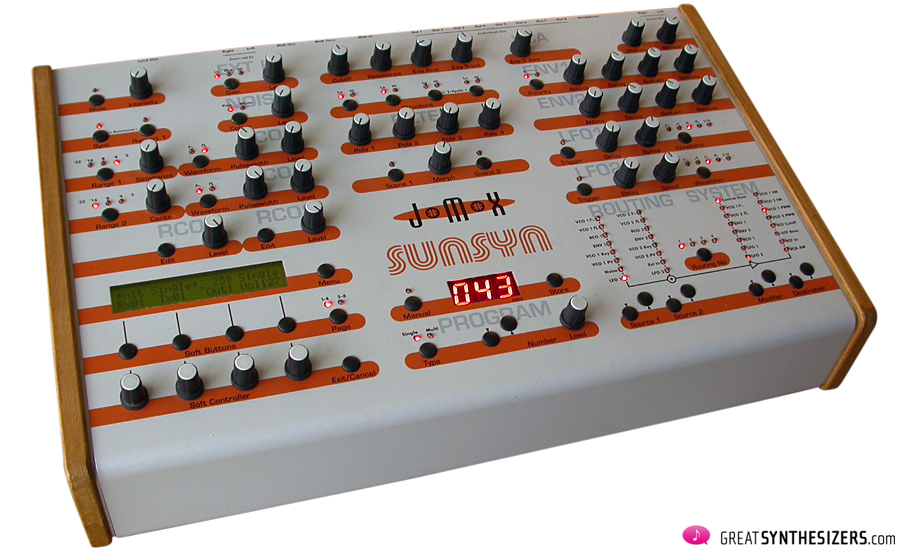

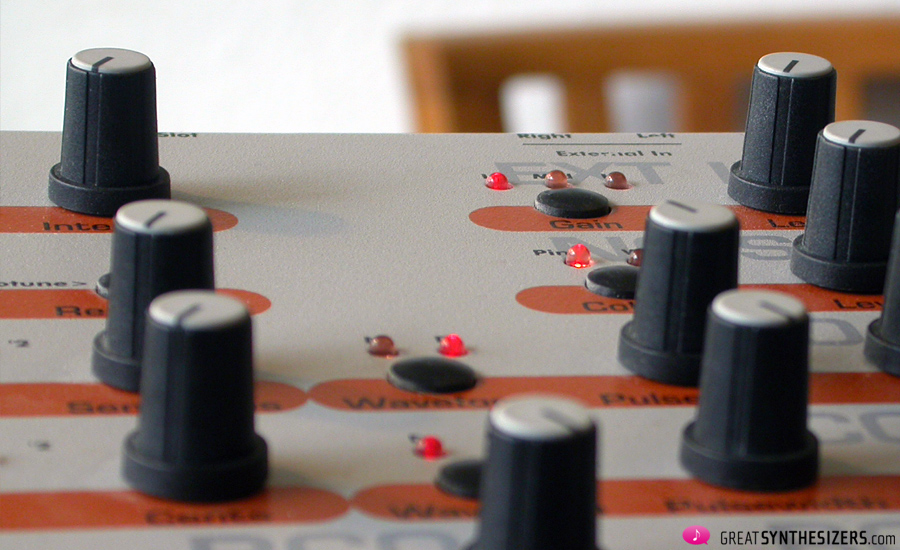
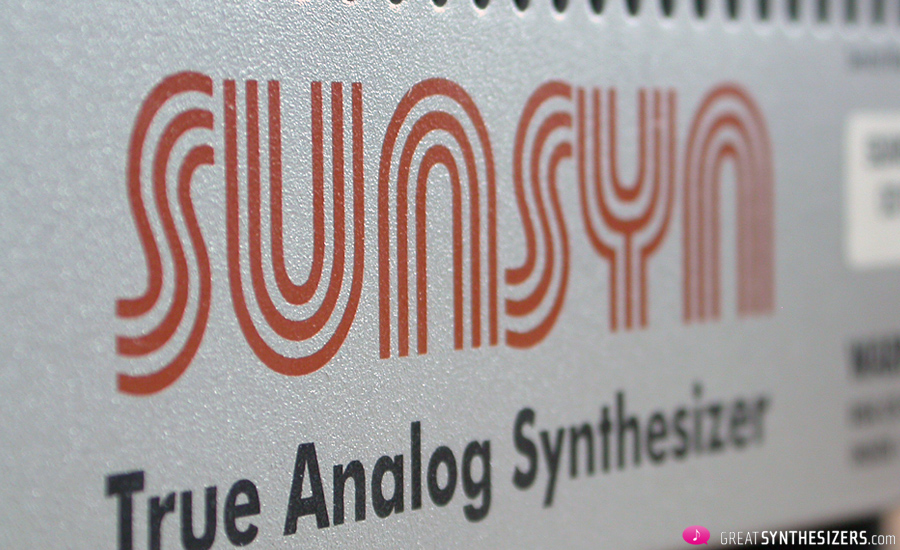
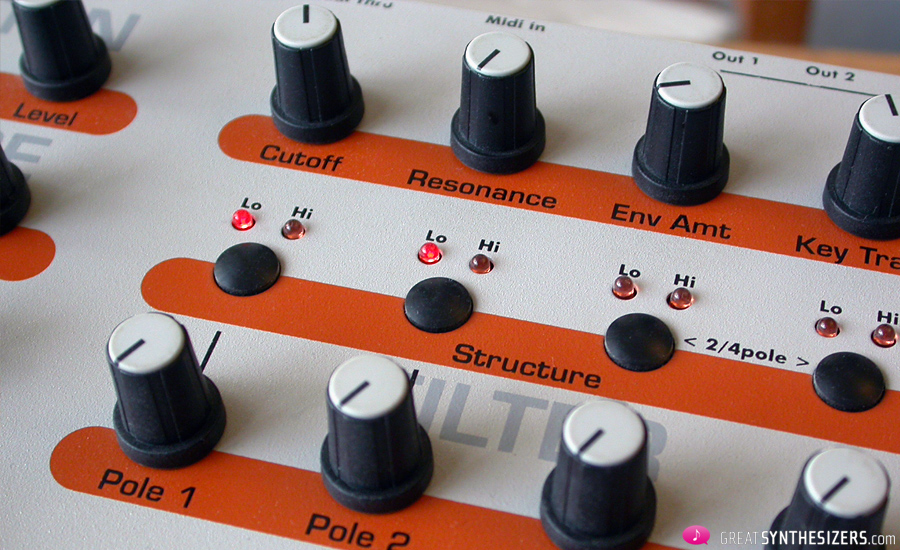
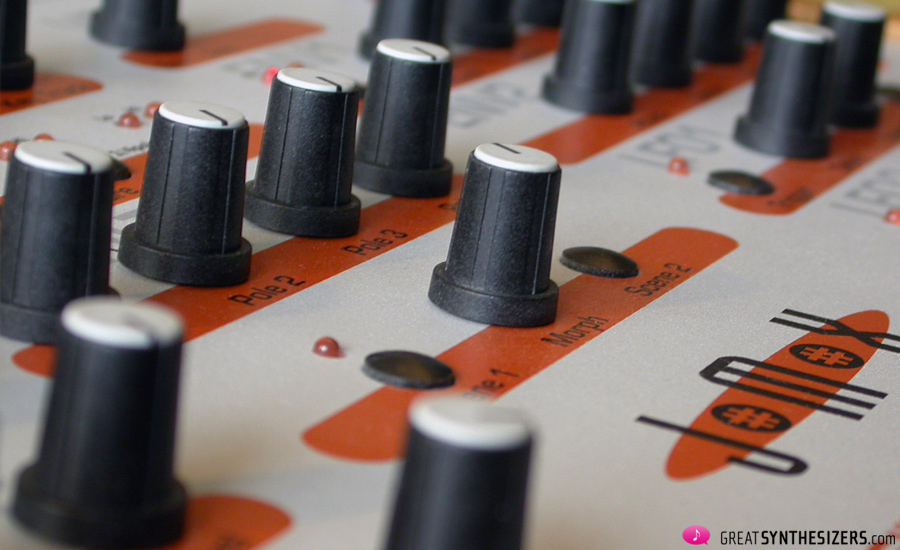
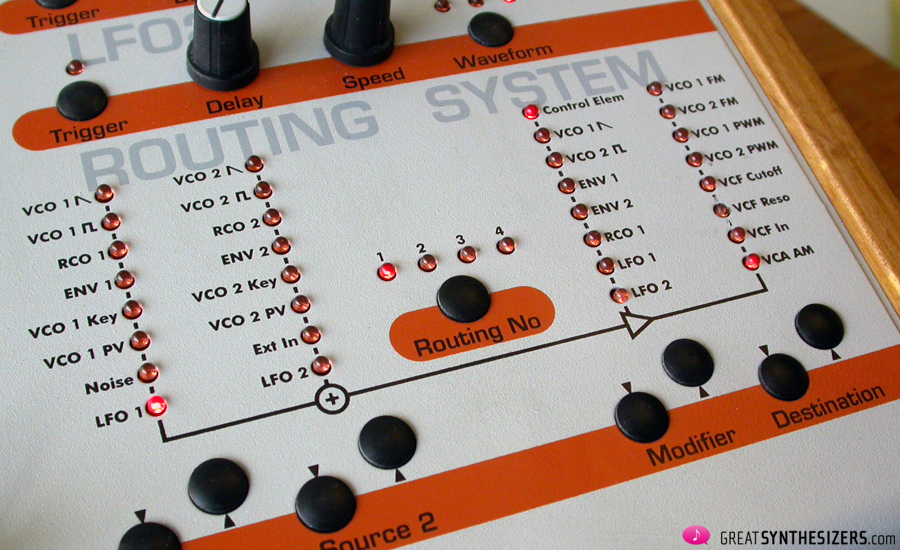
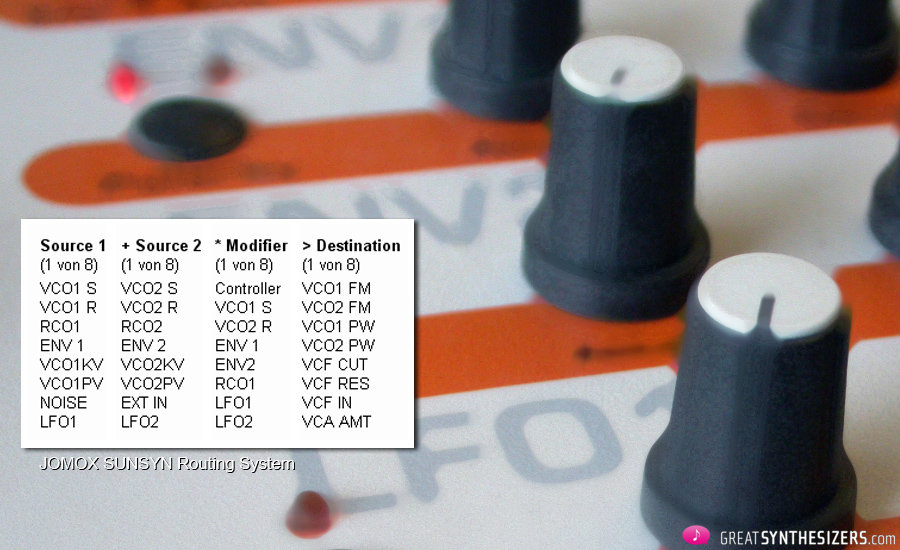
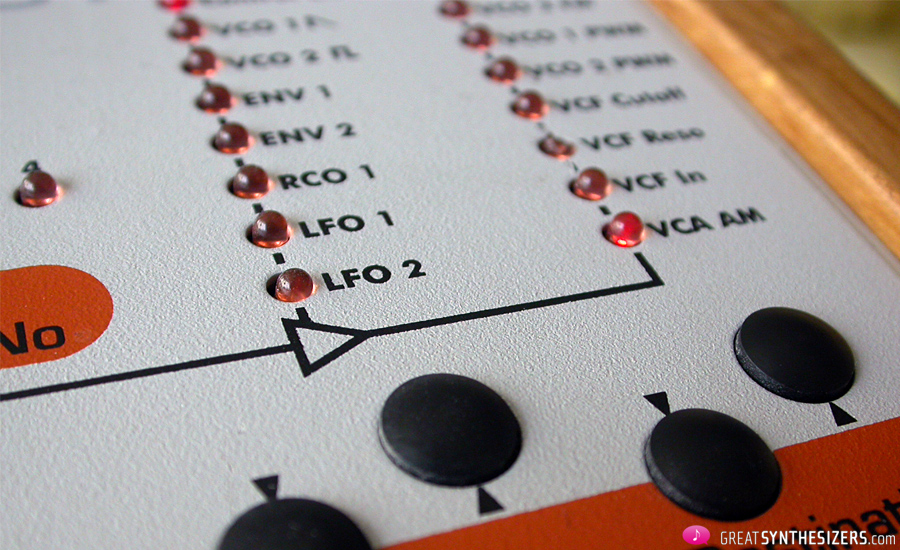
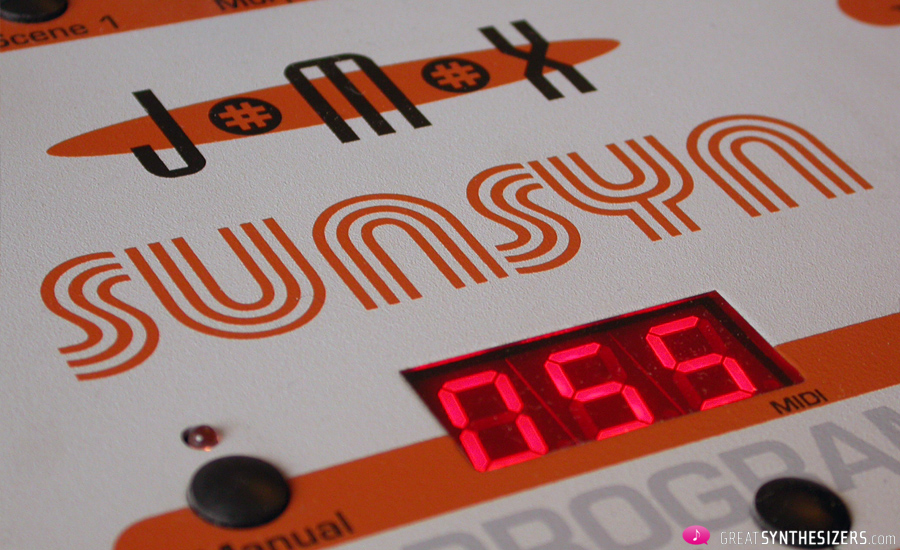
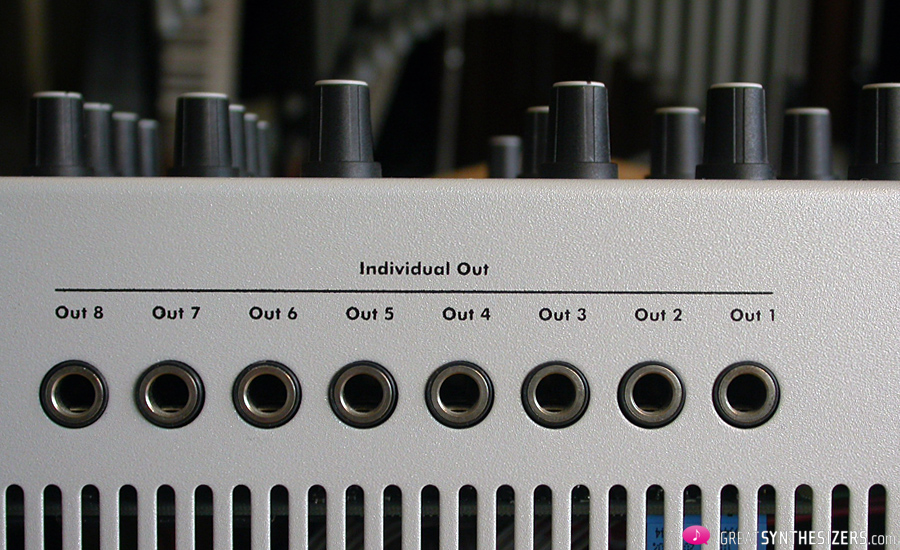
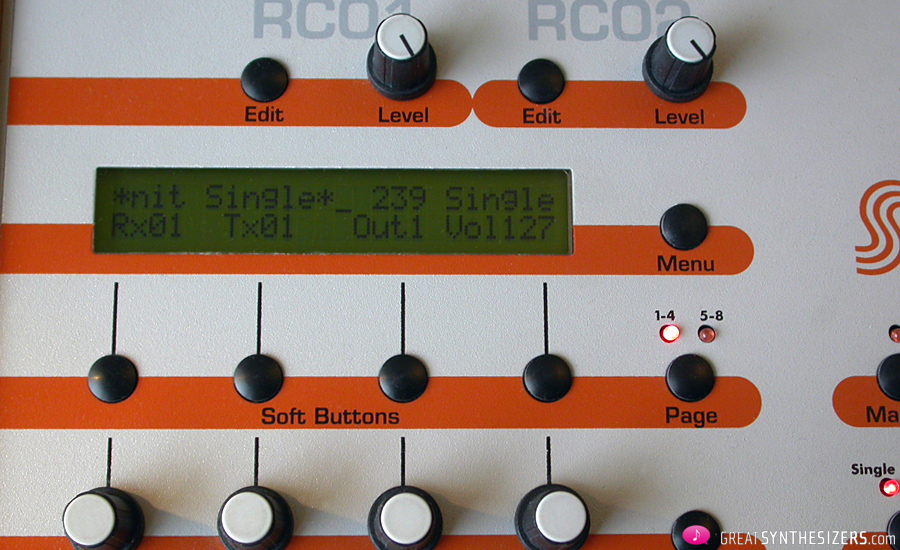


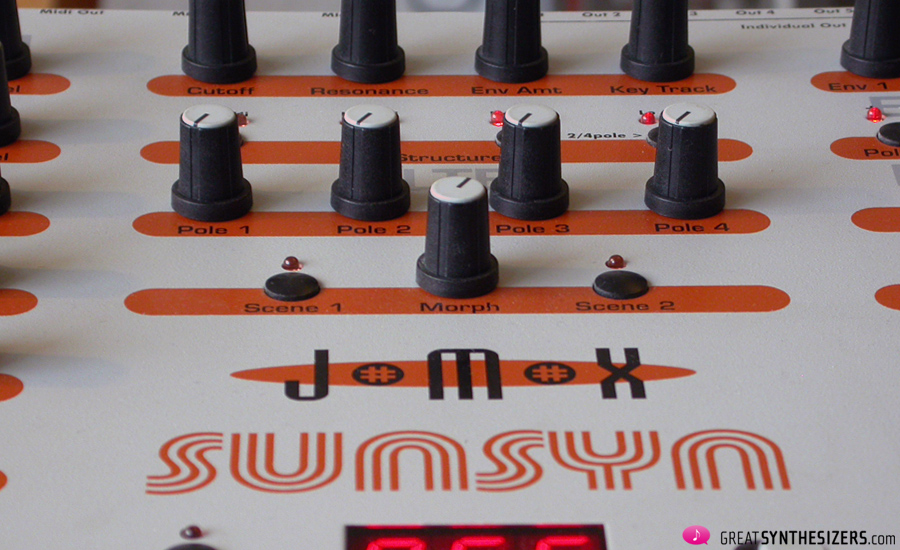
Thank you for great review and sound samples.
This machine is extremely deep and fantastic sounding. I have dozen of classical analogue synths and Sunsys is only modern poly analogue that represents improvement over benchmarks like Memorymoog, OBX, Prophet 5 and Jupiter 8. Yes, it is cleaner and less noisy, but it doesn’t sound plastic like other new synths like DSI or Andromeda.
MKII is as great as it can get. Fantastic.
Although I really LOVE that synth , I think that I will have to sell mine ?
It is in perfect condition and great working order, O.S. V.1.22 , and ,
if somebody is interested by its purchase , I live in FRANCE and will
ask 4500 € for it .
Cheers
Frédéric
Hello Fred,
hope you are doing well,
did you sell your SunSyn?
Contact me: pabloalexander at me dot com
best regards
Hey I was wondering if you somehow could modulate the filter morphing beside physically twisting the knob itself?
… hello Johan. Curt Nolte told me “no” … only manual control of SunSyn filter morphing possible (sadly). Regards …
Very nice overview. Thanks for posting the calibration instructions. I recently acquired a Sunsyn (OS 1.22) from a person who bought it from the original owner but realized it was too complex for them.
They decided to overwrite the Init Patch (255). Is there a way to download factory patches or do a reset to get the Init Patch back? Otherwise if someone would be kind enough to provide this to me that would be great.
Thanks!
Mark
Update: I received this from Jomox.
main menu -> edit -> more -> Init
makes an init patch
Thanks,
Mark
Does anyone here have a SunSyn for sale?
Regards
Kevin
on the off chance that you still have the synth, I’m a taker, and I live in Paris!
Great demos, thank you!
Sound example called “Vibrato Pad” really blow me away. I’m listening it on repeat for second day! In love with the sound. Please advise me, do you know any cheaper analog synth that can produce very similar sound? I need it in my music!
Morph CC#61
… thanks!
Demo “The Mission B Mas” – awe track!